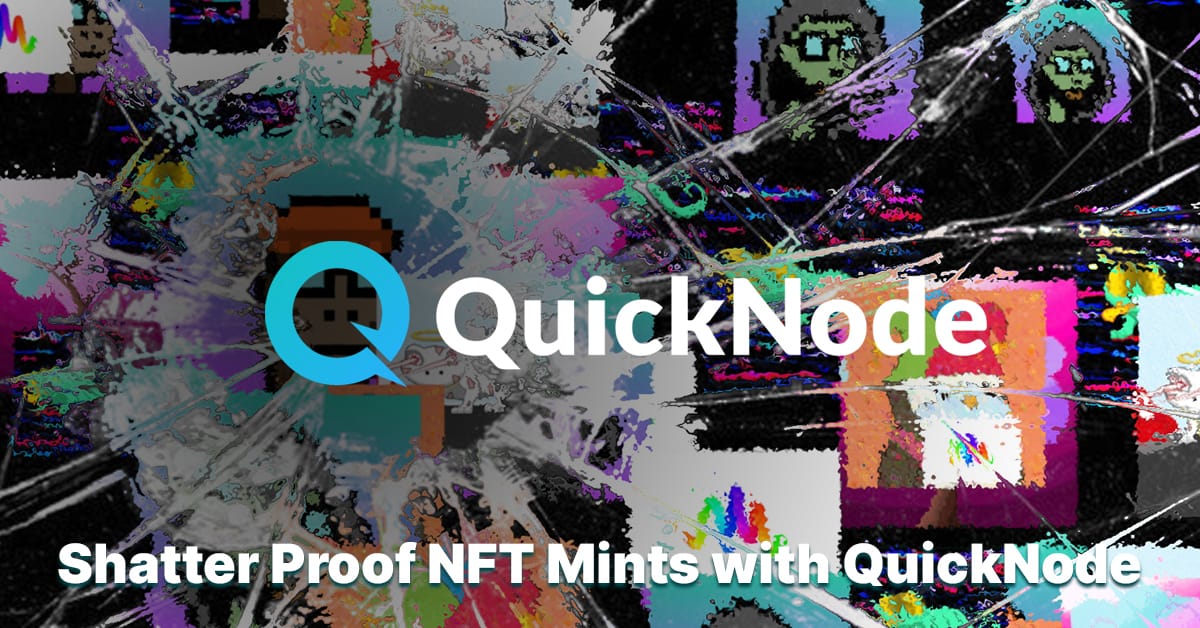Shatterproof NFT Mints with QuickNode
See how to create shatterproof NFT mints using QuickNode's reliable and secure blockchain infrastructure.

NFTs are all over the place and are one of the hottest blockchain applications right now. So what the heck is an NFT? Is it a token? Is it a JPEG? Or just magic? Let’s find out.
Non-fungible token (NFT) is unique and represents an asset on the blockchain. NFTs have given a medium for artists to monetize their work and for collectors to have transparency and authenticity with their purchases.
Another application of NFTs is collections, a company/platform comes up with a limited-edition collection of NFTs usually based on a theme, and they roll out these collections from time to time in their sales.
Complications during the building an NFT project
NFT contracts or programs in the case of Solana, reside on-chain, and to mint NFTs there is a need for interaction with these on-chain contracts and to do so we need a node to send/receive data to/from blockchains. Setting up a node can be difficult but maintaining it is even tougher. Let’s assume that you have an awesome idea for an NFT collection, you have all the arts ready and the contract for your NFTs ready. Following will be the steps:
- The first step will be to write the contract and set up the node, the node might require some time to sync the entire chain.
- Once the node is synced you’d have to deploy the contract on the blockchain.
- Once the contract is deployed, you can start with the marketing for your NFT drops and continue managing your node.
- Once you have the community all hyped up about your project you should be all set for your first NFT drop and yet again managing your node is an ongoing process here.
- Finally, the day comes when the sale goes live and there is an extraordinary response from the community. If the node/infrastructure can handle it? Awesome. But a lot of time it has been seen that during such sales the number of requests/second increases drastically and the nodes/infrastructure breaks and ruins the drop.
Here is where QuickNode helps its users. You can sign for a QuickNode on day one and you can easily remove all parts which say node/infrastructure from the above steps. QuickNode not only helps you create a node in seconds but also takes care of high demands. With its Elastic API QuickNode nodes are able to handle any number of requests sent to it. Faster transactions can also be a critical part of a presale/NFT drop. QuickNode has a global network of nodes, so when a transaction is sent using QuickNode it is fast and gets propagated throughout the global network of nodes which makes it easier for miners/validators to discover the transaction. So long story short, QuickNode helps you focus on all the other operations around your project, relieves you from all the time, work, and stress that goes into setting up and maintaining a node.
A lot of NFT projects particularly on Solana recently have used QuickNode as their infrastructure provider and have been quite successful.
Solamanders are NFT collections of unique Salamanders stored on the Solana blockchain. They had a launch on 4th September 2021. They chose QuickNode as their RPC provider to handle their big launch.
SolSouls: SolSouls had issues with node providers in their previous projects were due to the overwhelming response to their nodes crashing. They made their latest launch using QuickNode on 6th September 2021.
You can leave your worries about node/infrastructure to QuickNode and work on building your project.
Need help with your project or have questions? Contact us via this form, on Twitter @QuickNode, or ping us on Discord!
About QuickNode
QuickNode is building infrastructure to support the future of Web3. Since 2017, we’ve worked with hundreds of developers and companies, helping scale dApps and providing high-performance access to 16+ blockchains. Subscribe to our newsletter for more content like this and stay in the loop with what’s happening in Web3! 😃





